

Les jeunes accros à l'info (mais pas aux journaux) On les dit peu intéressés par l'actualité, méfiants à l'égard des médias traditionnels, scotchés à Facebook...
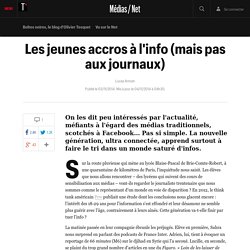
Pas si simple. La nouvelle génération, ultra connectée, apprend surtout à faire le tri dans un monde saturé d'infos. Sur la route pluvieuse qui mène au lycée Blaise-Pascal de Brie-Comte-Robert, à une quarantaine de kilomètres de Paris, l'inquiétude nous saisit. Les élèves que nous allons rencontrer – des lycéens qui suivent des cours de sensibilisation aux médias – vont-ils regarder le journaliste trentenaire que nous sommes comme le représentant d'un monde en voie de disparition ? En 2012, le think tank américain Pew publiait une étude dont les conclusions nous glacent encore : l'intérêt des 18-29 ans pour l'information s'est effondré et leur désamour ne semble plus guérir avec l'âge, contrairement à leurs aînés. La matinée passée en leur compagnie ébranle les préjugés.
Les jeunes et l'info, ça fait deux ? Social Media and the ‘Spiral of Silence’ A major insight into human behavior from pre-internet era studies of communication is the tendency of people not to speak up about policy issues in public—or among their family, friends, and work colleagues—when they believe their own point of view is not widely shared.
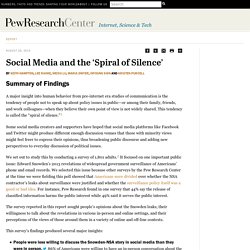
This tendency is called the “spiral of silence.” Some social media creators and supporters have hoped that social media platforms like Facebook and Twitter might produce different enough discussion venues that those with minority views might feel freer to express their opinions, thus broadening public discourse and adding new perspectives to everyday discussion of political issues. We set out to study this by conducting a survey of 1,801 adults. Deloitte: Demand for multiplatform content up. Digital omnivores – those consumers who own a trio of tablets, smartphones and laptops – continue to grow, driven by the proliferation of new platforms and increased device adoption.
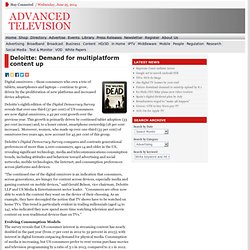
Deloitte’s eighth edition of the Digital Democracy Survey reveals that over one third (37 per cent) of US consumers are now digital omnivores, a 42 per cent growth over the previous year. This growth is primarily driven by continued tablet adoption (33 per cent increase) and, to a lesser extent, smartphone ownership (18 per cent increase).
Moreover, women, who made up over one-third (35 per cent) of omnivores two years ago, now account for 45 per cent of this group. Evolving Consumption ModelsThe survey reveals that US consumer interest in streaming content has nearly doubled in the past year (from 17 per cent in 2012 to 32 percent in 2013), with interest in digital formats outpacing demand for physical media. “This year’s results indicate an economic shift in the content industry. Shares, Pins, and Tweets - Journalism Studies - The early literature exploring online news established that online journalism often failed to explore interactive features and relied mostly on content from the parent publication.

Newsmaking decisions were driven by print newsrooms and articles for the online version rarely included external links or multimedia content. Quandt (200844. Quandt, Thorsten. 2008. Spritz. People Powered Front Pages Rule. What if front pages were selected by newspapers’ readers instead of their editors?

At NewsWhip, we’re always interested in the news stories people are choosing to share – and how those stories differ from the normal news stories editors put on the front pages of big newspapers. The battle for ‘Trayvon Martin’: Mapping a media controversy online and off-line. Mapping Twitter Topic Networks: From Polarized Crowds to Community Clusters. Polarized Crowds: Political conversations on Twitter Conversations on Twitter create networks with identifiable contours as people reply to and mention one another in their tweets.

These conversational structures differ, depending on the subject and the people driving the conversation. Six structures are regularly observed: divided, unified, fragmented, clustered, and inward and outward hub and spoke structures. These are created as individuals choose whom to reply to or mention in their Twitter messages and the structures tell a story about the nature of the conversation. If a topic is political, it is common to see two separate, polarized crowds take shape.
While these polarized crowds are common in political conversations on Twitter, it is important to remember that the people who take the time to post and talk about political issues on Twitter are a special group. What You Think You Know About the Web Is Wrong. The newsonomics of measuring the real impact of news. Hello there! It’s me, your friendly neighborhood Tweet Button. What if you could tap me and unlock a brand new source of funding for startup news sources of all kinds?
What if, even better, you the reader could tap that money loose with a single click? How can journalists measure the impact of their work? Notes toward a model of measurement. You know that old “If I had a nickel” saying?
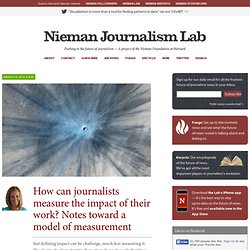
Well, if I had a nickel for every time I’ve heard the word “impact” — and impacting, impactful, impacted, high impact, etc. — since I joined the Center for Investigative Reporting as media impact analyst in July, I could go straight from my position as an ACLS public fellow to retirement. Presse écrite : 38 % des lecteurs lisent sur support numérique. Quartz UX Teardown: How to Design and Create Engaging Email Newsletter User Experiences.
E-newsletters: still a ‘powerful medium’ for engagement. "Email is the main cog in the social media machine," Lynda Moyo, What's On editor at Manchester Evening news and Trinity Mirror Regionals, told Journalism.co.uk of her experience in writing newsletters.

"You can't have a Twitter or Facebook without an email address. " It may not be as visible or public as social media or a website, but email is still the main channel by which the world communicates online. A 2013 study estimates the number of worldwide email accounts to be 3.9 billion, with more than 180 billion emails sent each day. As such, an email newsletter is as valuable a channel to reach readers as any other, but some are more successful than others. This how-to guide shares tips from some industry experts who have found regular, engaged readers in the newsletters they produce. We are drowning in data about readers and attention, but which metrics really matter? You won’t like the answer. Thanks to the web and real-time measurement tools, the media industry has gone from having virtually no hard data on readers and attention to an embarrassment of riches — not only can we measure what people click on, but we can measure how far down the page they got when they were reading, whether they posted a comment, which social networks they came from, and a hundred other pieces of data.
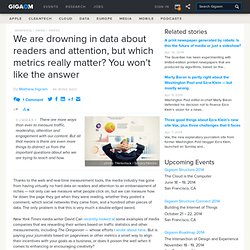
The only problem is that this is very much a double-edged sword. New York Times media writer David Carr recently looked at some examples of media companies that are rewarding their writers based on traffic statistics and other measurements, including The Oregonian — whose efforts I wrote about here. But is paying your journalists based on pageviews or other metrics a smart way to align their incentives with your goals as a business, or does it poison the well when it comes to enhancing or encouraging creativity?
Be careful what kind of incentives you use. Jburnmurdoch : .@felixsalmon "Breaking news ... The future of media isn’t about breaking news scoops, it’s about credibility and trust. As I was nursing my 50th cappuccino in Perugia during the recent journalism conference there, a small bomb blew up in my Twitter feed thanks to a keynote presentation by Felix Salmon, in which the former Reuters blogger said that the journalistic obsession with scoops is a form of masturbation.
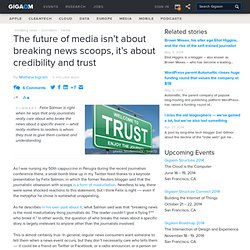
Needless to say, there were some shocked reactions to this statement, but I think Felix is right -— even if the metaphor he chose is somewhat unappealing. As he describes in his own post about it, what Salmon said was that “breaking news is the most masturbatory thing journalists do. The reader couldn’t give a flying f*** who broke it.” In other words, the question of who breaks the news about a specific story is largely irrelevant to anyone other than the journalists involved.
This is almost certainly true. Mobile divided: Why social media app “unbundling” still has risks. When it comes to the mobile strategy of social media companies this year, one notable trend is the rise of “unbundling.” Facebook CEO Mark Zuckerberg touted the company’s decision to separate Messenger from its core app as a way to give its users discrete, distinct experiences.
Foursquare announced earlier this month that it would break apart its existing app into two new ones: the “new” Foursquare focused on location discovery, and a check-in focused app called Swarm. The decision to break a larger, bulkier app into smaller, sleeker experiences could help many social media companies tap into new countries while providing richer, more focused experiences. Facebook’s product guy is right, the media sucks — but journalists are also right: Facebook has to share the blame. Watching the audience move: A New York Times tool is helping direct traffic from story to story. Since its creation last April, The New York Times’ News Analytics team has been working closely with editors and reporters to introduce audience insights into our journalistic decision-making — one of the key newsroom initiatives the Times has identified as being critical to our success. The questions our team is asked are usually focused on numbers: “How many visits did my article get?”
Is one of the most popular. But we’ve found the more interesting questions are the implicit ones, embodied in the assumptions and habits of the newsroom. Questioning the thinking behind statements like “we do this because this is how we’ve always done it” has been the best starting point to uncovering interesting and useful insights about our audience. One example has been in our coverage of big news events, which we tend to blanket with all of the tools at our disposal: articles (both newsy and analytical) as well as a flurry of liveblogs, slideshows, interactive features, and video. Probably not a surprise: Turns out your boss spends a lot of time in email — reading news. Do you work in a handsome corner office, one with a view? If so, you likely get a lot of your news in your inbox. Of course, that’s true for many non-captains of industry too. But a new survey from Quartz looks specifically at the news habits of business executives and finds them — despite widespread adoption of mobile devices, with their panoply of apps and streams — still tethered to an old Internet classic.
Sixty percent said that an email newsletter is one of the first three sources they turn to in the mornings for news — far ahead of dedicated news apps, social networks like Twitter, or news sites on mobile or desktop. LIVE BLOG: Quantifying Journalism: Data, Metrics, and Computation. Share on Tumblr From left: Amanda Cox, Dan Gardner, and Mark Hansen. Update on Medium’s Paid Collection Experiments — The Story. The homepage is dead! We’re building one anyway. Lecture print vs écran selon le SPS. Le Syndicat de la presse sociale (SPS) qui représente 100 éditeurs (mutuelles, syndicats et associations) et plus de 120 publications, vient de publier une étude réalisée par Seprem Etudes et Conseil sur le comparatif de lecture print vs la lecture sur écran. Et pour 65% des personnes interrogées, la lecture sur papier est « au moins hebdomadaire », sans réel décrochage chez les plus jeunes, relève l'étude. La fréquence de lecture « au moins hebdomadaire » sur supports digitaux est quant à elle équivalente au global, mais est toutefois beaucoup plus importante chez les « moins de 35 ans » (70%).
The New York Times is looking to machine learning to help it understand reader behavior. You might not think an applied mathematician who does research in biology and has a PhD in theoretical physics would have much to offer a 163-year-old newspaper publisher, but Chris Wiggins, head of the data science team at the New York Times, told attendees at the Structure conference in San Francisco that machine learning can do much the same thing for media companies as it does for research biologists: namely, make sense of a whole pile of data.
In the case of the Times, that data is about things like what pages readers look at, how long they spend reading them, what they click on or read before and afterwards — and especially how that behavior relates to the paper’s advertising and the reader’s desire to sign up for or renew a subscription. What Internet Users Do Online Pew Research Center's Internet & American Life Project. The Personal News Cycle How Americans choose to get their news - American Press Institute GBC. Facebook news 10-24-2013. ENP Workshop Report. 8 Key Takeaways about Social Media and News Pew Research Center's Journalism Project. Deloitte. One 20112012 note resultats. One 2012 presentation des resultats.
Pew-tablets21. Presentation Donnees Generales AudiPresse Premium 2013. PEJ 12.03.12 Fig.2a NewsOnAnyDevice-024. PEW2014 Key-Indicators-in-Media-and-News-2014. PEW2014 Overview GBC. PEW2014 Revnue-Picture-for-American-Journalism. PEW2014 Shifts-in-Reporting For-uploading. Pew - State of the News Media 2013. Pew Research Center - 2012 News Consumption Report. Pew where people get news yesterday. Pew facebook news 10-24-2013 GBC. Screen Shot 2012-09-27 at 12.00.58 PM. The Personal News Cycle How Americans choose to get their news - American Press Institute GBC. The Public appetite for foreign news on TV. What Internet Users Do Online Pew Research Center's Internet & American Life Project. Facebook News Feed Redesign Changes Struggle to Court Users - Mike Isaac - Social.
Most people think of Facebook in a similar way: It’s a place to share photos of your kids. It’s a way to keep up with friends and family members. It’s a place to share a funny, viral story or LOLcat picture you’ve stumbled upon on the Web. This is not how Facebook thinks of Facebook. In Mark Zuckerberg’s mind, Facebook should be “the best personalized newspaper in the world.” Publishers Nervously Await The Facebook "Correction" Spike. Barry Schwartz: Le paradoxe du choix. The not-so-quaint charm of the email newsletter. In spite of today’s obsession with social networks, the email newsletter remains a potent vector for the dissemination of news and for driving traffic back to websites.
Netflix: Binge Watching Is The New Normal For TV Streamers. CNN-viewership_610x259.jpg (Image JPEG, 610 × 259 pixels) How Do Millennials Like to Read the News? Very Much Like Their Grandparents - Derek Thompson. News that anticipates the reader’s needs. The year 2014 is going to be all about you. A snapshot of UK newspaper social sharing habits. Startups such as Buzzfeed and UsVsTh3m have proved it's possible to build a huge audience using social media, but platforms such as Facebook and Twitter are also increasingly important to the newspaper industry as a way of exposing themselves to as wide an audience as possible.
News is bad for you – and giving up reading it will make you happier. Rolf Dobelli's ideas about not needing news are dangerous. Why do journalists prefer Twitter to Facebook? News Use across Social Media Platforms. CHART OF THE DAY: The Difference Between What You Share And What People Want To Read. Sharing fast and slow: The psychological connection between how we think and how we spread news on social media. Viral Journalism and the Valley of Ambiguity. De l’état des pages d’accueil sur les sites d’informations français. Pocket shows the power of data in picking stories. What’s the best way to measure attention online? Upworthy thinks it has the answer. How people read online: Why you won’t finish this article. Why so serious? Maybe because data shows news stories can get shared just as often as lighter fare.
La recommandation, passage obligé pour les diffuseurs. Is this article too long or too short? Why newspapers are writing the wrong articles for the web. An Article Has A Lifespan Of 37 Days, And Other Findings From Pocket. Sources for News. Twitter News Consumers: Young, Mobile and Educated. Pew Survey Sizes Up Condé Naste's Unspammable Reddit: A Newspaper Model From The Future? -SVW.
The Influence of Brand. Qui sont réellement les acheteurs de presse au format numérique ? More mobile devices equals more news consumption, says study. Etudes. "Un Français sur deux lit un quotidien chaque jour"... mais bien sûr ! Why tablet magazines are a failure. What’s New in Digital Scholarship: Chasing pageviews, news on Facebook, and the search for the golden metric.
18 ways to take mobile seriously in 2014. Why Audiences Hate Hard News—And Love Pretending Otherwise - Derek Thompson. The mobile majority: Engaging people on smartphones is the next big challenge to the news. What’s real? Engaging News Project. The Changing Face of News Consumption, Hosted by WSJ on Livestream. #14 - The Knowledge. Frédéric Filloux. Mapping Twitter Topic Networks: From Polarized Crowds to Community Clusters. Social or search...this obsession with traffic ignores the complexity of turning readers into revenue. On Not Caring About The News Why the definition of news must change in the digital age. Deux tiers des Français suivent l'actualité plusieurs fois par jour. Content economics, part 5: news. What to Measure? The Question Journalism Has to Answer. Sit up and pay attention: A new age for metrics?